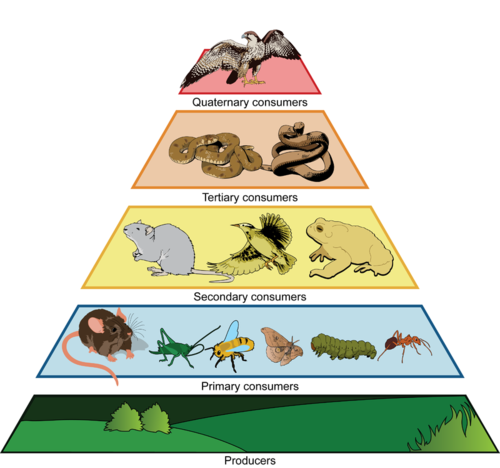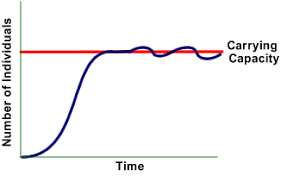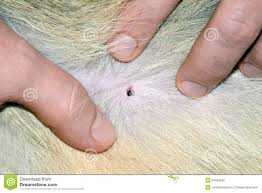Ecology
Relations among organisms and their interactions with their environment is known as Ecology.
Biodiversity: term used to describe the variety of life found on Earth.

Individual = 1 Species
Population = Many of the same speices
Community = Different populations (Biotic Factor = living)
Ecosystem = Various populations along with abiotic factors (non-living) coexisting.
Biome = Many ecosystems (Tundra, Tropical Rain Forest, Desert, etc...)
Biosphere = Many biomes


Abiotic Factors are non-living. Ex: rocks, soil, water, wind, temp.
Biotic Factors are any living. Ex: Plants, Animals, Fungi, Bacteria, and Protists.


Producers = get their energy and produce their own food by use of non-living resources. They are also called autotrophs.
Consumers = organisms get their energy from living or once living resources such as plants, animals, fungi, bacteria. They are also called heterotrophs.
Law of Conservation of Energy
Energy can not be created or destroyed it can only be transferred from one form to another.
Our Sun is our source of energy. It provides direct and indirect energy to all life on earth.

In Ecology we see interactions among populations mainly through Food Chains and Food Webs
Food Chains show how the organisms are related with each other by the food they eat. The arrow indicates the direction energy travels. They are very simple.


Food Webs are a combinations of Food Chains interacting with one another. They are very complex.

Only a 10% of energy is transferred from organism to organism while the rest is lost to heat. TEN PERCENT RULE

There are 4 Types of Consumers
- Herbivore = organisms that only eat plants
- Carnivore = organisms that only eat meat
- Omnivore = organisms that eat both plants and meat.
- Decomposers /Detritivores = organisms that eat decaying matter and recycle it back to the environment.
Each organism in an environment can be placed in what is known as a Trophic Level, usually represented as a pyramid.
In a Trophic Level Pyramid each level symbolizes a level of nourishment in a food chain.


Biomass Pyramids indicate how much of a certain organism there is in a specific area. Producers occupy most of the land biomass.
Population size is affected by 4 major events:
1. Migration = population moves into an area from another (pop. increases).
2. Births = new organisms are produced (pop. increases).
3. Deaths = organisms die (pop. decreases).
4. Emigration = population moves out from an area and into a new one (pop. decreases).
Many times certain areas can only sustain so much life. This is known as Carrying Capacity (how much capacity a certain area can sustain).
So when population of consumers increase there are changes in the environment that can lead to deaths in populations until order is restored.


Organisms interact with their environment differently. Within a certain ecosystem, organisms tend to occupy their own space called a niche.
A habitat is a place organism lives and a niche is how an organism lives within a habitat.
There are 3 factors that are included in a niche:
1. Food = the type of food it eats, how it competes with others for food, and where in the food web it falls into.
2. Abiotic Conditions = temp. and water a organism can tolerate.
3. Behavior = when the organism is active
Sometimes organisms occupying different niches will compete for food and drive other out of their area.
Some prey upon others in different niches when hunting. This is called predation, the act of preying upon another organism with the intent to kill and eat it.
Other organisms will interact with each other in a process known as known as symbiosis.
There are 3 forms of Symbiosis:
1. Mutualism = (mutual) both organisms benefit from the relationship. Ex: Bees and flowers.



2. Parasitism: (parasite) one organism benefits while the other gets harmed in the process. Some parasites ultimately kill the host. Ex: Dogs and ticks.



3. Commensalism: one organism benefits while the other is not affected or not bothered. Ex: Sharks and remora.


Predation is not a form of symbiosis but it deals with relationships between 2 organisms. One organisms benefits while the other is killed


Ecological Factors will also limit and impact an Ecosystem.
Density-Dependent Limiting Factors = Factors that affect individuals living in an area. Ex: Competition, Predation, and Disease.
Density-Independent Limiting Factors = Factors that limit a population regardless of size. (Factors organisms can not control) Ex: Natural disasters, Weather, Human Activities in an area.
Ecosystems are affected by many factors and can lead a populations to fluctuate over time. Sometimes environments are struck hard by natural disasters and these events cause populations to migrate.
Areas affected by these events may take many years to return to their once normal state.
There are two types of Successions:
1. Primary Succession = event that causes new areas to form from scratch. Ex: Volcanic eruption/Glacier melt and creates a new bare area for life to begin. Takes longer to create a sustainable environment.

2. Secondary Succession = event that causes an environment to be destroyed and only soil remains. Ex: A forest fire destroys an large area and no trees remain.

Review for EXAM!!!
Ecology Exam Review
1. A group of organisms of the same species that live in the same area is called a(n) *
2. Which phrase best describes biodiversity? *
3. Organisms that feed on dead or decaying matter are called *
4. What do all the biotic and abiotic factors in a given area make up? *
5. What biotic or abiotic factor provide most of the energy in ecosystems? *
6. List examples of biotic factors and abiotic factors? *
7. Which model shows the number of organisms at each trophic level in an ecosystem? *
8. Decide what symbiotic relationship this example is describing. A tree provides food and shelter for an ant that protects the tree from invaders. *
9. Decide what symbiotic relationship this example is describing. A snake devours a field mouse. *
10. Decide what symbiotic relationship this example is describing. A tapeworm absorbs nutrients from the intestine of a dog. *
11. Decide what symbiotic relationship this example is describing. A bee collects nectar from a flower and spreads its pollen in return. *
12. Plants, Animals, Fungi, Bacteria are all examples of *
13. In a food pyramid, which level contains the greatest amount of energy? *
14. Zebras live on the savannas of Africa. A watering hole on the savanna would be part of a zebra’s *
15. Which of these is an example of parasitism? *
16. Which of the following will increase the size of a population? *
17. Which of the following is a density-dependent limiting factor? *
18. Hawaii’s lush tropical forests arose from a process of *
19. The reestablishment of a damaged ecosystem in an area where the soil is intact is called *
20. An example of primary consumers for this food web is *
21. An example for secondary consumers in this food web is *
27. Which organisms do primary consumer mainly eat? *
28. In an area off the Antarctic coast, elephant seals consume 200,000 calories of squid and small fish. How much energy must these squid and fish consumer to sustain the elephant seal population? *
29. A raccoon consumes 500 Calories of food. 50 of those Calories are converted to biomass. In other words *
30. A rain forest has a high level of biodiversity because it has *
Biodiversity: term used to describe the variety of life found on Earth.
Individual = 1 Species
Abiotic Factors are non-living. Ex: rocks, soil, water, wind, temp.

Law of Conservation of Energy
Our Sun is our source of energy. It provides direct and indirect energy to all life on earth.
Food Chains show how the organisms are related with each other by the food they eat. The arrow indicates the direction energy travels. They are very simple.

There are 4 Types of Consumers
- Herbivore = organisms that only eat plants
- Carnivore = organisms that only eat meat
- Omnivore = organisms that eat both plants and meat.
- Decomposers /Detritivores = organisms that eat decaying matter and recycle it back to the environment.
In a Trophic Level Pyramid each level symbolizes a level of nourishment in a food chain.

Population size is affected by 4 major events:
1. Migration = population moves into an area from another (pop. increases).
Many times certain areas can only sustain so much life. This is known as Carrying Capacity (how much capacity a certain area can sustain).
So when population of consumers increase there are changes in the environment that can lead to deaths in populations until order is restored.
Organisms interact with their environment differently. Within a certain ecosystem, organisms tend to occupy their own space called a niche.
A habitat is a place organism lives and a niche is how an organism lives within a habitat.
There are 3 factors that are included in a niche:
Sometimes organisms occupying different niches will compete for food and drive other out of their area.
Some prey upon others in different niches when hunting. This is called predation, the act of preying upon another organism with the intent to kill and eat it.
There are 3 forms of Symbiosis:
Predation is not a form of symbiosis but it deals with relationships between 2 organisms. One organisms benefits while the other is killed
Density-Dependent Limiting Factors = Factors that affect individuals living in an area. Ex: Competition, Predation, and Disease.
Ecosystems are affected by many factors and can lead a populations to fluctuate over time. Sometimes environments are struck hard by natural disasters and these events cause populations to migrate.
Areas affected by these events may take many years to return to their once normal state.
There are two types of Successions:
2. Secondary Succession = event that causes an environment to be destroyed and only soil remains. Ex: A forest fire destroys an large area and no trees remain.
Ecology Exam Review
1. A group of organisms of the same species that live in the same area is called a(n) *
2. Which phrase best describes biodiversity? *
3. Organisms that feed on dead or decaying matter are called *
4. What do all the biotic and abiotic factors in a given area make up? *
5. What biotic or abiotic factor provide most of the energy in ecosystems? *
6. List examples of biotic factors and abiotic factors? *
7. Which model shows the number of organisms at each trophic level in an ecosystem? *
8. Decide what symbiotic relationship this example is describing. A tree provides food and shelter for an ant that protects the tree from invaders. *
9. Decide what symbiotic relationship this example is describing. A snake devours a field mouse. *
10. Decide what symbiotic relationship this example is describing. A tapeworm absorbs nutrients from the intestine of a dog. *
11. Decide what symbiotic relationship this example is describing. A bee collects nectar from a flower and spreads its pollen in return. *
12. Plants, Animals, Fungi, Bacteria are all examples of *
13. In a food pyramid, which level contains the greatest amount of energy? *
14. Zebras live on the savannas of Africa. A watering hole on the savanna would be part of a zebra’s *
15. Which of these is an example of parasitism? *
16. Which of the following will increase the size of a population? *
17. Which of the following is a density-dependent limiting factor? *
18. Hawaii’s lush tropical forests arose from a process of *
19. The reestablishment of a damaged ecosystem in an area where the soil is intact is called *
20. An example of primary consumers for this food web is *
21. An example for secondary consumers in this food web is *
27. Which organisms do primary consumer mainly eat? *
28. In an area off the Antarctic coast, elephant seals consume 200,000 calories of squid and small fish. How much energy must these squid and fish consumer to sustain the elephant seal population? *
29. A raccoon consumes 500 Calories of food. 50 of those Calories are converted to biomass. In other words *
30. A rain forest has a high level of biodiversity because it has *
No comments:
Post a Comment